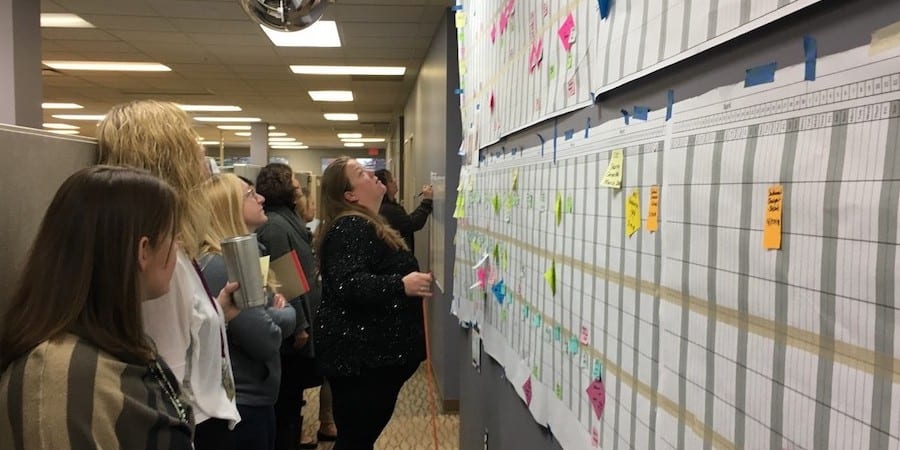
What kind of bureaucrat are you?
FEATURE – In this in-depth, insightful analysis, the authors explore the essence of bureaucracy and explain why, with Lean Thinking, it can be leveraged as a force for good.
Words: Michael Ballé and Klaus Beulker
How can the fish be aware of the water in the fishbowl? How can we be aware of the bureaucracy surrounding us when it is increasingly all we know, other forms of organization have disappeared or are fading away? It is easy to feel that everything is going from bad to worse in our world, and that nothing works as it should anymore. It is much harder to see our own part in it, that we are the ones holding and promoting the same bureaucratic values and reflexes that make everything dumb, dull, and tasteless.
WHAT IS A BUREAUCRACY?
What is a bureaucracy? These days, we tend to use the word to refer to red-tape, excessively complex, centralized and burdensome procedures that make the simples things in life a hassle. But, in truth, bureaucracy is a system for organizing people. It can be a good thing or a bad thing, depending on how it is understood and interpreted. Our modern form of bureaucracy appeared in Prussia in the 18th century, essentially to organize the army more efficiently by professionalizing officers and protecting them from the arbitrariness of aristocrats. The idea was to squeeze individuals into a role, ruled by… rules and processes. People would then be promoted through a chain of command according to how well they adhered to bureaucratic principles.
Bureaucracy is so scalable because of its context-free nature: its reflex is always to solve a specific problem by a general rule that can be applied independently of local situations. That is how we end up with European Union rules on how bendy bananas should be. What makes bureaucracy powerful also makes it incredibly dumb – and often absurd – because, to us individuals, in our specific context, rules often don’t make any sense. Bureaucratic thinking endeavors to make explicit every tacit situation (tacit in the sense that we know more than we can tell) and then establish a rule, procedure, standard, that will take human arbitrary judgment out of the process. Digitalization has rapidly expanded the dominion of bureaucracy, by taking humans out of human processes and replacing them by inflexible coded systems.
Bureaucracies are essentially instruction and compliance machines, balancing a chain of command with rules, regulations, processes and, today, systems (digitally coded processes). The concept draws its power from the fact that it gives people very little leeway to use resources overtly for their own personal benefit, as this would go against the rules. In this, bureaucracies differ from other modes of human organization, such as traditional communities – where rights and duties are distributed according to informal, traditional arrangements and offerings to chiefs in exchange for privileges and favors – or network organizations that are built around one-to-one or one-to-many negotiated deals, exchanges, transactions, and so on, without a central enforcing authority. Bureaucracies are very powerful because they limit and constrain individual power and initiative. As a result, power in a bureaucracy accumulates towards the top, precisely because it is sustained by rules and not free arrangements – and, unfortunately, in the end, oligarchies.
The price we pay for the overall efficiency of bureaucracies is effectiveness. They make everything explicit by taking away context. Each response a bureaucracy comes up with is efficient overall, but poorly adapted to specific situations.
Obviously, leaders of bureaucracies are not blind to their fundamental ineffectiveness and are constantly trying to correct it by more directly linking activities to objectives. Ironically, they do so by bureaucratic means, such as management-by-objectives, pay-for-performance, budgeting, and so on, thus adding layers of controls to the bureaucracy. They also see the need for change and modernization, which they seek by imposing technocratic changes, all invariably context free – often adding chaos to the system.
A bureaucracy has essentially two elements:
- A steering board of some sort, what happens at the top where leaders discuss strategies and plans. This is where goals and methods collide, often in overtly political ways that all others within the machine find scary and distasteful.
- Rowing units that have a defined purpose and performance and are essentially about executing specific tasks through division of labor. Bureaucracies scale by organizing this division of labor in departments and functions, which tend to multiply as more specialisms are needed. Since the basic information transfer in a bureaucracy occurs through the chain of command, this makes things even more awkward as information has to go all the way up to the steering level to pass from one silo to the next.
The more coupled the steering and rowing parts of a bureaucracy get, the more unwieldly it becomes, with steerers committed to their specific rowing actions and rowers confused by steering discussions. The upshot is the bureaucratic language of management, where words and concepts are used to essentially say nothing – the origin of what has become known as “bullshit jobs”.
WHAT TURNS BUREAUCRACY INTO RED TAPE
Bureaucracy makes sure that trains run and that garbage gets collected. It is essential to our way of life. What it doesn’t do is do things smartly, such as making trains run on time and garbage being properly sorted for recycling. This is not a bug; it’s a design flaw. Bureaucracies develop red-tape in well-known and avoidable way, such as over-administration by functions, over-centralization of decision-making, confusing outputs and outcomes, promotion of aggressive, over-simplifying callous leaders who play the system for personal advancement, and, overall, their own transformation into bloated institutions rather than lean mission-driven organizations. This mostly has to do with bureaucratic leaders not understanding the nature of the beast, and making things worse when they think they are making them better.
The dominant ailment of any bureaucracy is the over administration of its own activities, mostly by adding controls to the existing control mechanisms and confusing steering and rowing. Here’s an example. Rather than just looking at the missing positions and hiring based on minimum qualification, an overly bureaucratic HR department will not resist the urge to add new requirements, arbitrarily decide how to recognize talent, make those criteria explicit, and define processes. As a result, a hiring process that could be done in a simple interview to filter out those unsuited for the job turns into a full evaluation that will slow every hire down, make good candidates run away, and eventually ensure that positions remain unfilled. The absurdly bureaucratic part of it is that the candidate eventually selected by HR as a “talent” is not likely to succeed any more than someone with basic qualifications who proves themselves in the job. After all, what does HR know about real work or leadership? Since every functional department tends to act this way, the machinery of the bureaucracy typically grinds to a halt with no visible benefit, and all see it.
Similarly, the command-and-control structure of bureaucracies tends to circulate information upwards as bosses demand more reporting, and encourages misinformation and misdirection, as bosses also decide who gets promoted and who gets castigated. No one likes the bearer of bad news and ambitious bureaucrats become experts in presenting information in quite the right way and deflecting blame for unfavorable information on others, within the environment of neighboring departments (with whom they often have longtime feuds). As a result, decision making becomes centralized, as bureaucrats both avoid taking decisions (to keep away from possible blame) and enjoy doing the job of the people under them (to affirm their control). Worse, the information on which central decision-making is based is usually flawed, sometimes fatally, because of the very reporting systems and processes in place. Decisions become polarized into two extremes: either do nothing or do something completely crazy to “shake things up” and “move things forward” – what is called “ultra-solutions” with catastrophic effects.
The command (issuing instructions) and control (checking execution) theory of bureaucracy leads to an easy confusion between steering and rowing, as it confuses outcomes (general performance results of our actions) with outputs (narrow, specified results). Another theory of command-and-control, more suited to distinguishing steering and rowing, first defines the general target (command intent) and then checks for overall effects (situational awareness) – what are we aiming for? Where are events taking us? To do so requires strong steering frameworks (having ways to distinguish moving forwards from backwards) and independent intelligence resources invested in measuring impact without being invested in the policies themselves – something perfectly unnatural for ambitious bureaucrats who will do all they can to get rid of them or suborn them.
Bureaucratic leaders are clearly aware that the system delivers poorly, so they constantly seek to improve things by optimizing operations. Ambitious upcoming bureaucrats can then turn into technocrats and commit to pushing a new process or system on the organization to get it to change. This kind of change is often defined for its own sake, with the appropriate success measure, and creates a bureaucratic battlefield between the change agent and the holders of established positions – leading to more processes being added to those already in place, thoroughly confused rowing units, and disengaged employees. This has been done repeatedly to large organizations, such as hospitals, where the focus has largely changed from taking care of patients to taking care of the various systems and processes in place that stop you from actually looking at a patient’s specific needs.
Overall, these mechanisms turn bureaucracies into institutions, human systems with the single aim of keeping themselves as they are, regardless of the performance of their service or the demands of the environment. Until the environment damages them permanently or breaks them up, that is. The opposite of an institution is a mission-driven organization, where the bureaucracy’s red-tape is deliberately tempered by clearly separating steering (purpose and mission) from rowing, constantly checking the consequences of policies and how they are applied, encouraging context-smart initiative from officers, and promoting people with a strong sense of outcomes as well as outputs (who understand the human needs of both customers and staff and have learned to balance bureaucratic necessities, situational flexibility and basic human compassion). Handled well, bureaucracies can become enabling bureaucracies that use their mechanisms to promote competence rather than compliance and help people get what they want done.
WHAT DOES IT TAKE TO BE A GOOD BUREAUCRAT?
A good bureaucrat acknowledges (and defends) the power of bureaucracy. They realize how useful rules are to deal with confusing or emotionally tense situations. They understand how roles limit self-interest and feathering one’s nest at the expense of others. They know that processes get things done and repeatable processes get things done repeatedly (even though not necessarily reliably). Finally, they’re firm believers in promoting according to merit rather than personal connections. However, good bureaucrats also grasp how damaging runaway administration can become, how cold and heartless it can be to apply rules without context, and how red-tape bureaucracy can destroy trust (and therefore performance).
What, then, is a good bureaucrat to do? The key point is to balance bureaucratic rules, roles, and processes with context:
- Avoid giving instructions (and checking execution) and start negotiating. What is the best win-win deal we can find with anyone in the current circumstances, which will make the situation progress towards a mutually acceptable agreement and improved performance?
- Clarify ultimate targets in terms of benefit to society. Remind everyone that the mission of the bureaucracy is providing service to its users, not making things easier for itself.
- Decentralize with autonomous officers through education and initiative. Fight the tendency of the bureaucracy to over-centralize every decision by encouraging field officers to think for themselves (through education) and take initiatives (to find compromises in context).
- Protect maintenance budgets. Make sure that the basic enabling activities of the bureaucracy work and avoid unnecessary modernizing initiatives from technocrats (like a new ERP).
- Promote people who both achieve results and are well liked by the people they command, as well as their colleagues. Good officers should be both aggressive in seeking results and collaborative in achieving performance with both their staff and other departments.
By understanding the explicating, context-free, and centralizing nature of bureaucracies, we can figure out how to make them work better. Good bureaucrats are the one who understand, within limits, the need for special circumstances, human reactions, and systemic change. Good bureaucrats understand that steering discussions must be open (what got us here? Where should we go next?), that operational leaders must have enough leeway to deal with local circumstances and express insight and initiative, and that agents of the bureaucracy must be able to express their humanness, their foibles, emotional lives, need for rewarding interactions, and search for meaning. Bad bureaucrats, on the other hand, take context free solutions to extremes. These are people who take measures to simplify their own work by imposing arbitrary order, regardless of the performance consequences and social impact of their actions.
Where does lean fit into all of this? Lean, it turns out, was devised by Toyota executives as an antidote to bureaucracy – or, as they called it, “big company disease”. The normal productivity model of a bureaucracy is to seek cost advantage through volume. To do so, it creates a system to optimize activities regardless of context, thereby creating stocks and backlogs. The need to produce also means that quality is the responsibility of a bureaucratic department and ignored by most rowing units, which should all be organized from the same pattern regardless of local conditions.
Lean Thinking turns this idea on its head. First, it advocates for team leaders who lead their teams to organize and run their own workshops with 5S, focusing on safety in the process. Then it empowers each rowing unit to oversee its own quality, making it the job of the team leader to solve context-dependent problems. Units are then coordinated through pull systems in order to reduce lead-times, which requires front-line managers to coordinate and solve yet more contextual problems. Volume costs advantages are achieved by eliminating bureaucratic waste from processes by solving problems at the lowest levels of the hierarchy. Lean leaders ensure that the bureaucracy remains context-focused through “gemba walks”, during which they go and see what happens, get people to agree on problems and commit to kaizen – continuous improvement.

This lean attitude impacts the bureaucratic system by bringing context to it at four levels:
- Challenges: steering discussions are context-rich, based on an attempt to figure out what is changing out there and how the organization should adapt. The questions are: 1) “what are the contextual challenges?”, and 2) “what do we keep and what do we need to change?”.
- Kaizen: at rowing level, all units are supposed to continuously improve their value to internal and external customers and overall performance by engaging lower-level teams in kaizen activities, and solving contextual problems as a matter of course, which generally involves adapting rules and processes to specific situations.
- Pull coordination: silos are threaded by strings of coordination, whether chief engineers or pull systems, in order for managers to resolve any blockages in the workflow.
- People development: the focus on contextual problem solving requires spotting and promoting competence rather than compliance, which in turn requires significant investments in training and education to develop people individually, personally, and professionally. People are treated as individuals, and the focus of the organization is on teams and team leaders
Seeking to understand people’s context (“respect” in Toyota terminology) is the key to create interpersonal trust, which, as we know, is also the key to collective performance. Trusting that context will be taken into account and that the chain of command will behave as a chain of help also creates the conditions for human learning in solving similar problems in varying contexts. This requires leaders to constantly focus on three basic trusts:
- Trust customers have that the service they need will be performed with competence and care;
- Trust employees have in their internal systems to that they help rather than hinder;
- Trust individuals have in their hierarchy, trusting that their immediate superiors will help them resolve personal difficulties rather than bury them for it.
Learning to solve the problems to build up this trust, case after case, adds up to a collective intelligence that creates a very different kind of bureaucracy – one that is helpful rather than unhelpful. One that performs out of intelligence rather than brute force and seeking overwhelming advantage. One that can adapt competitively to changing circumstances year after year.
Lean is not antibureaucratic. It relies on making tacit knowledge explicit as much as any bureaucratic system. It recognizes the need for roles and rules, as well as processes and systems. In contrast with other organizational models, however, it adds the mysterious ingredient of “kaizen spirit” to seek to create an enabling bureaucracy (as opposed to a red tape one). Most lean programs flounder because they fail to understand the nature of bureaucracies and so, unwittingly, turn lean principles and tools into added layers of bureaucratic absurdity, thus making matters worse. When leaders understand the nature of the beast, however, and use lean properly, they succeed spectacularly by making the bureaucracy work for their customers, for their people and in the context of changing market conditions. So, ask yourself: what kind of bureaucrat are you?
THE AUTHORS


Read more


FEATURE – This article (and video) explains how Michigan Medicine applied lean product and process development tools and methods to their clinical processes. A powerful experiment.



INTERVIEW – Is “lean fire-fighting” an oxymoron? It isn’t if you are the Grand Rapids Fire Department, which has not only turned itself around but is also leading a city-wide lean transformation.


FEATURE – What if we ran our production schedule to time instead of quantity? While creating overproduction, running to time is a temporary first step to establish levelled production with fixed repetitive cycles.


FEATURE – The successful project discussed in this article shows how Lean Thinking can bring huge benefits to small and medium enterprises and paves the way to a new way of looking at lean coaching.

